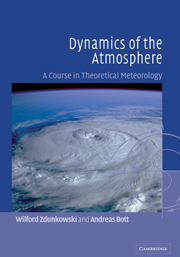Book contents
- Frontmatter
- Contents
- Preface
- Part 1 Mathematical tools
- Part 2 Dynamics of the atmosphere
- 1 The laws of atmospheric motion
- 2 Scale analysis
- 3 The material and the local description of flow
- 4 Atmospheric flow fields
- 5 The Navier–Stokes stress tensor
- 6 The Helmholtz theorem
- 7 Kinematics of two-dimensional flow
- 8 Natural coordinates
- 9 Boundary surfaces and boundary conditions
- 10 Circulation and vorticity theorems
- 11 Turbulent systems
- 12 An excursion into spectral turbulence theory
- 13 The atmospheric boundary layer
- 14 Wave motion in the atmosphere
- 15 The barotropic model
- 16 Rossby waves
- 17 Inertial and dynamic stability
- 18 The equation of motion in general coordinate systems
- 19 The geographical coordinate system
- 20 The stereographic coordinate system
- 21 Orography-following coordinate systems
- 22 The stereographic system with a generalized vertical coordinate
- 23 A quasi-geostrophic baroclinic model
- 24 A two-level prognostic model, baroclinic instability
- 25 An excursion concerning numerical procedures
- 26 Modeling of atmospheric flow by spectral techniques
- 27 Predictability
- Answers to Problems
- List of frequently used symbols
- References and bibliography
- Index
13 - The atmospheric boundary layer
Published online by Cambridge University Press: 05 June 2012
- Frontmatter
- Contents
- Preface
- Part 1 Mathematical tools
- Part 2 Dynamics of the atmosphere
- 1 The laws of atmospheric motion
- 2 Scale analysis
- 3 The material and the local description of flow
- 4 Atmospheric flow fields
- 5 The Navier–Stokes stress tensor
- 6 The Helmholtz theorem
- 7 Kinematics of two-dimensional flow
- 8 Natural coordinates
- 9 Boundary surfaces and boundary conditions
- 10 Circulation and vorticity theorems
- 11 Turbulent systems
- 12 An excursion into spectral turbulence theory
- 13 The atmospheric boundary layer
- 14 Wave motion in the atmosphere
- 15 The barotropic model
- 16 Rossby waves
- 17 Inertial and dynamic stability
- 18 The equation of motion in general coordinate systems
- 19 The geographical coordinate system
- 20 The stereographic coordinate system
- 21 Orography-following coordinate systems
- 22 The stereographic system with a generalized vertical coordinate
- 23 A quasi-geostrophic baroclinic model
- 24 A two-level prognostic model, baroclinic instability
- 25 An excursion concerning numerical procedures
- 26 Modeling of atmospheric flow by spectral techniques
- 27 Predictability
- Answers to Problems
- List of frequently used symbols
- References and bibliography
- Index
Summary
Introduction
The vertical structure of the atmospheric boundary layer is depicted in Figure 13.1. The lowest atmospheric layer is known as the laminar sublayer and has a thickness of only a few millimeters. It is difficult to verify the existence of this layer because of its small vertical extent. Within the laminar sublayer all physical processes such as the transport of momentum and heat are regulated by molecular motion. In most boundary layer models the existence of this layer is not explicitly treated. It stands to reason that there also exists some type of a transitional layer between the laminar sublayer and the so-called Prandtl layer where turbulence is fully developed.
The lower boundary of the Prandtl or surface layer is the roughness height z0 where the mean wind is assumed to vanish. The vertical extent of the Prandtl layer is regulated by the thermal stratification of the air and may vary from about 20 to 100 m. In this layer all turbulent fluxes are approximately constant with height. The influence of the Coriolis force may be ignored this close to the earth's surface, so the turning of the wind within the Prandtl layer may be ignored. The wind speed, however, increases very strongly in this layer, reaching a value of more than half the wind speed at the top of the boundary layer.
- Type
- Chapter
- Information
- Dynamics of the AtmosphereA Course in Theoretical Meteorology, pp. 349 - 397Publisher: Cambridge University PressPrint publication year: 2003



